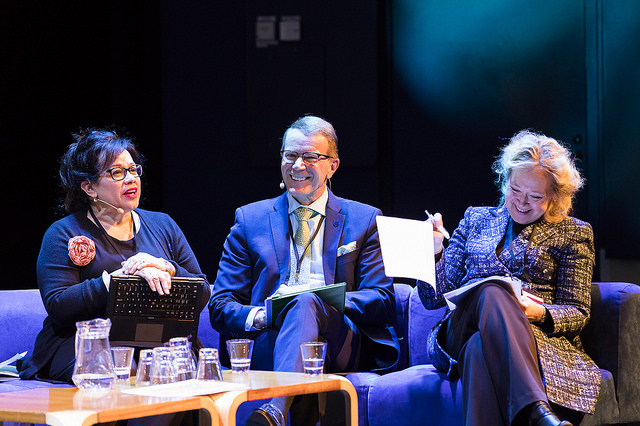
How to ensure a responsible use of natural resources in the Arctic?
16.11.2017
What do we mean by a resilent Arctic bioeconomy and how can we strengthen it? Natural and social ecosystems were the theme of one of the first panels on the second day of the Rovaniemi Arctic Spirit Conference.
"Because of the multiple expectations and pressures towards the region, fostering the resilience of the natural and social systems of the Arctic is more and more important" – said Jari Leppä, Finnish Minister of Agriculture and Forestry, in his video greeting launching one of the first panel discussions of the second day of the Arctic Spirit Conference, "Resilience and sustainable bioeconomy in the Arctic".
One of the most important parts of the bioeconomy of the Arctic is forest and its ecosystem. We have to recognize the special situation of forests in Europe – said Ivonne Higuero, Director at the Forests, Land and Housing Division of UNECE. Although the numbers are quite optimistic as the forest covers 42 percent of the EU27 land area, forest ecosystems face many challenges. Illegal logging, lowering demand for wood and timber due to the financial crisis, and the use of forest products in the perspective of the climate change are among the most pressing issues of today's forestry. In countries of the Arctic that depend on national resources for economic development, these challenges need to be considered with particilar care, highlighted Ivonne. How to face them? Ivonne Higuero stressed that the bioeconomy in the Arctic relies on the cooperation on both national and international level between various stakeholders, including governments, private sector and academia.
Pentti Hyttinen, Director General of the Metsähallitus, drew attention to the pre-conditions for the sustainable and responsible forest management. As forest managers, we hold responsibility for the future generations, stressed Pentti Hyttinen. To ensure the good management of the forests, we need reliable data. At the moment, there is a large information gap that forest industry hopes scientists can help fill. "We do not have the full picture of how to manage forests in the way best for the environment", Metsähallitus Director General said.
On the other hand, the industry has to discuss with local people and listen to the public when it comes to planning of forests as social acceptance is crucial in that matter. Forests are not just a source of the raw materials – in the Arctic, they are multipurpose, they are for example also used by tourism industry and reindeer herders. "Sustainable forestry is more about the people than trees", Pentti Hyttinen concluded.
But how to ensure that everyone's voice is hears? Mia Landauer from the Risk and Resilience Program and Arctic Futures Initiative said that the first step is to make sure that people are interested in your project and that they realize that what you are doing is important and relevant to their lives. One of the challenges of communicating with local communities is that governments and industry have to first understand their lifestyles. "For example, public hearings on the future of forests in the Arctic should not be organized when the reindeer herders have the busiest period of the year", Mia Landauer explained.
Suvi Sojamo from Aalto University in Helsinki highlighted that in the multi-stakeholder processes of natural resources use and governance there may be major differences between capacity and power of different stakeholders to engage, some of them local communities and some global businesses. Therefore safe spaces are needed where the less-resourced parties can gather and form their stance.
"We should also bring the know-how to the local communities", added Virpi Alenius from the Natural Resources Institute. "We need to equip indigenous peoples with the knowledge about how to refine the resources of the nature so that they are able to turn them into a business on their own".
The business perspective on the topic was brought to the discussion by Hannu Ylinenpää who works at the Lappset Group Ltd. "It is important that we use raw materials from the region against resources from other parts of the world", he said.
One of the challenges for the competitiveness of the Arctic businesses is that most of them are small entreprises. Virpi Alenius noticed that smart specialization and management of the value chain are crucial in the Arctic: "We have to increase awareness that one business does not have to cover the whole value chain, but that they can be a part of it by creating partnerships with other entreprises".
|